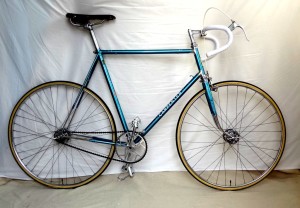
Dural had been around since the Zeppelins of WW1 but only gained limited acceptance, mainly with Continental makers of hubs, rims and pedals. Dural proved too fragile to be used for bars, stems, brakes or chainsets. However, Rolls-Royce had developed the alloy further in the late 1920s with their RR50 range first used in the pistons of the ‘R’ aero-engine in the Schneider Trophy seaplanes then in Spitfire Merlin engines. High Duty Alloys, a Reynolds subsidiary, introduced RR56 seatpins and forged stems in about 1937. The seat pins seem to have been taken up more readily than the bar stems – who would want to suffer a breakage? But after WW2 High Duty Alloys/ Reynolds were able to successfully re-introduce forge-able Hiduminium (as RR56 was branded) to bike component suppliers – the alloy was regarded highly enough to be specified for the heat-stressed skin of Concorde. So in the post-war bike boom there came a general acceptance of aluminium alloy components and a renewed interest in reducing bike weight. In the first place Reynolds supplied their own finished components – bars, stems, wing nuts, lamp brackets. They also supplied forgings and tubing to Stratalite and Gerry Burgess’s GB who successfully launched Hiduminium brakes too. Soon steel had been supplanted on all but sprint track bikes where strength was still prized. Track pursuit bikes and road time-trial bikes soon bristled with aluminium alloy parts.
Footnote: How did the major British component makers respond? Chater-Lea stayed faithful to steel. So did Williams (despite their pre-war ‘Dureel’ rings). Both lost out to French TA and Italian Campagnolo cotterless chain sets – Williams’ AB77 chainsets came too late. British Hub Co. responded too slowly to Campagnolo with a quick-release version of their steel barrelled Airlite hubs. Lyotard edged Brampton and other pedal makers aside. Once the dominant British component suppliers, these companies disappeared from the market. Smaller manufacturers like Harden and Hobbs were more innovative but only GB built up enough scale to survive long. Harsh lessons for a once proud but complacent industry.
Carpenter #4296 Supalite Special. Lightweight time trial model fitted with all lightweight components: 8.7 kg in race trim with Conloy/Harden sprints.
Frame: Reynolds 531. Note: Weight weeny or not, it still has a lamp bracket!
Race wheels: Harden LF dural hubs, drilled, 15T fixed sprocket, Conloy Duralumin sprint rims, 32/40 spokes; Reynolds Hiduminium wingnuts or tracknuts to rear for forceful riders.
General riding wheels: Harden LF dural hubs, undrilled ‘bacon slicers’, 21T fixed sprocket, Conloy Asp 27″ HP rims, drilled 32/40 spokes. Reynolds Hiduminium wingnuts as above.
Transmission: Lyotard 460 Course Duralumin pedals; 48 tooth Williams Dureel chainring on BSA steel cranks; Bayliss-Wiley Featherweight bottom bracket (hollow spindle). Renolds chain. (Actually I use a less-worn TA 50T chainwheels for quick rides).
Saddle: Brooks Swallow. Reynolds Hiduminium seatpin.
Steering: Reynolds Hiduminium Maes bend bars, Reynolds stem. Lytalloy headset
Brakes: GB Hiduminium brake and lever (forged by Reynolds). Same for rear brake if ever a hub gear fitted.
8.7 kg. as fixed wheel.
Frame restoration – Argos, Bristol.
Events: Various EGCC ‘Tens’; Tin-can ‘Ten’ (fitted with SA AC close ratio hub and a second brake), Chronosquadra Versilia 30k 4-up.